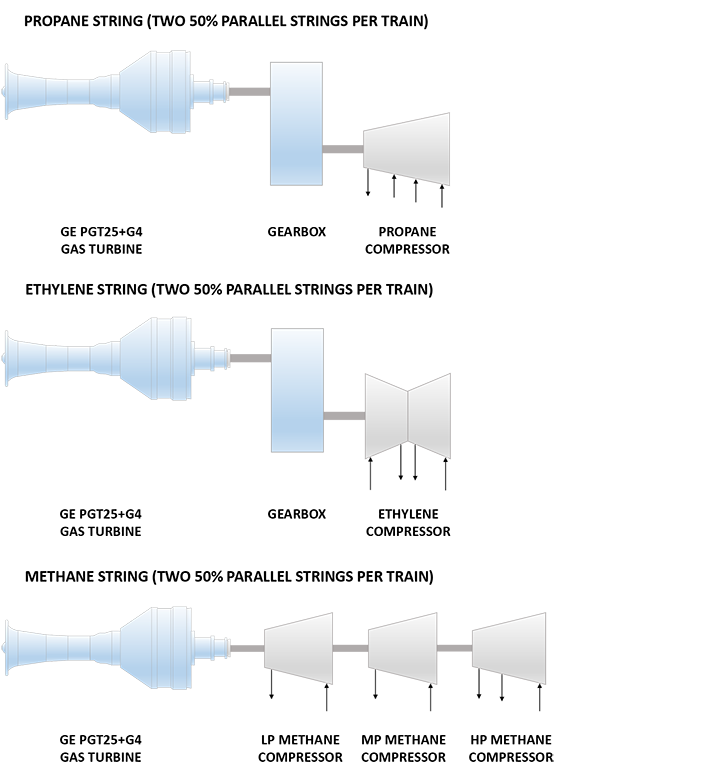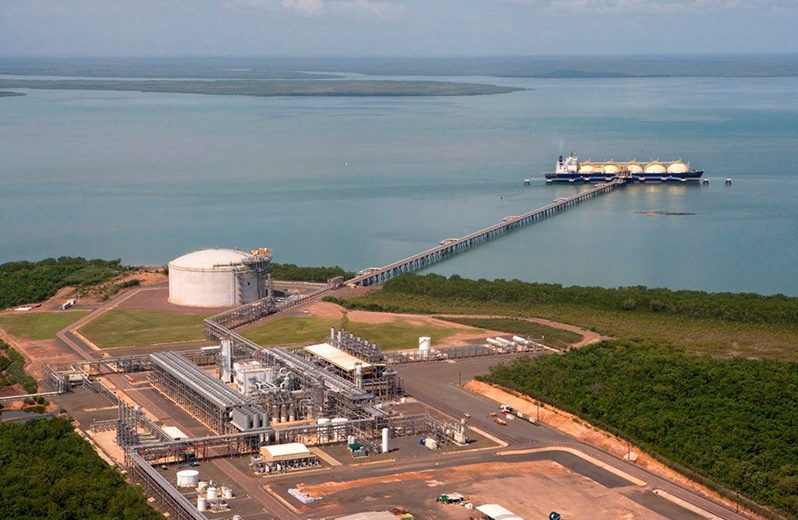In 1995, the discovery of the Bayu-Undan Field in the Timor Sea, approximately 500 kilometres north west of Darwin, seeded the idea of building an LNG plant at Wickham Point in Darwin Harbour. In 2002, heads of agreement were signed with Toyoko Electric and Toyko Gas for the sale of 3 MMTPA of LNG, prompting construction of the first LNG plant in the Northern Territory in June 2003.
A 502 km subsea pipeline, to supply gas to the plant, was finished in 2005. In January 2006, Darwin LNG became the 2nd LNG plant to be commissioned in Australia, that too ahead of schedule and within the allocated budget. The plant boasts of having an above ground LNG tank, with a working capacity of 188,000 cubic meters, one of the largest of its time. The projected life of the Bayu-Undan field will be reached in 2022. Discussions are already underway to extend the life of Darwin LNG through supply from several alternative sources.
Back in 2001, ConocoPhillips introduced training and capacity building programs at Timor-Leste to empower its nationals with the skills required for oil and gas jobs. Darwin provides 300-350 direct jobs and collaborates with the local industry for its various requirements. The project was the first of its kind to use high efficiency, low emission aeroderivative gas turbines for refrigerant drivers, in addition to deploying multiple design features to mitigate greenhouse gas emissions.
Onshore shale gas reserves in the Northern Territory are estimated at 200 Tcf, which are abundant to transform Darwin into a mammoth LNG hub. In April 2018, the ban on fracking in the region was lifted, however concern from indigenous groups, farmers and environmental factions necessitated strict environmental compliance standards to be developed.
OWNERSHIP (Equity %)
| ConocoPhillips | 56.94% |
| ENI | 10.99% |
| Santos | 11.50% |
| INPEX | 11.38% |
| Tokyo Timor Sea Resources | 9.19% |
General Data
| Estimated Capital Cost (USD) | 1.6 B |
| Plant Type | Onshore Stick-built |
| Plant Stage | Operating |
| Final Investment Decision (FID) Year | 2003 |
| FEED Contractor | Bechtel |
| EPC Contractor | Bechtel |
| No. of Trains / capacity | 1 Train / 3.7 MMTPA |
| Production Start Year | 2006 |
| Products | LNG, LPG, Condensate |
| Gas Type | Non-associated Gas (NAG) |
Technical Data
| Cooling Media | Air |
| Liquefaction Technology | CoP Optimized Cascade® |
| Refrigeration Train Details: | |
| Propane Strings 1 & 2 | |
| Driver | GE PGT25+G4 SAC (upgraded from PGT25+) Aeroderivative Gas Turbine |
| Gearbox | Double Helical Speed Reduction Gearbox |
| Propane Compressor | 3MCL1405 GE (Nuovo Pignone) Horizontally Split Centrifugal Compressor |
| Ethylene Strings 1 & 2 | |
| Driver | GE PGT25+G4 SAC (upgraded from PGT25+) Aeroderivative Gas Turbine |
| Gearbox | Double Helical Speed Reduction Gearbox |
| Ethylene Compressor | 2MCL1006 GE (Nuovo Pignone) Horizontally Split Centrifugal Compressor |
| Methane Strings 1 & 2 | |
| Driver | GE PGT25+G4 SAC (upgraded from PGT25+) Aeroderivative Gas Turbine |
| LP Methane Compressor | MCL806 GE (Nuovo Pignone) Horizontally Split Centrifugal Compressor |
| MP Methane Compressor | MCL806 GE (Nuovo Pignone) Horizontally Split Centrifugal Compressor |
| HP Methane Compressor | BCL608 GE (Nuovo Pignone) Radially Split Centrifugal Compressor |
Refrigeration Train Configuration

Key Facts
- Darwin LNG was the first LNG plant in the world to use aeroderivative gas turbines (GE PGT25+) as refrigeration compressor drivers. In 2010, the LNG facility uprated the turbines to GE’s PGT25+G4 units as part of a debottlenecking effort. This uprated engine provides an increase in power of approximately 10%, by means of an increase in flow and a modest increase in control temperature.1
- At Darwin LNG, nitrogen oxide (NOx) emissions from the aeroderivative gas turbines are controlled by utilizing water injection into the combustor. At the time, ConocoPhillips had been using water injection for NOx reduction on LM 2500 gas turbines in the United States for over 8 years (since 1996).2
- Darwin LNG, at its time of coming into existence, had employed several first-to-use design concepts including,3
> the largest above ground LNG tanks constructed at the time with a 188,000m3 capacity
> use of a ground flare instead of a conventional stack to minimize visual effects from the facility and any intrusion on aviation traffic in the Darwin area
> use of an enhanced version of vacuum jacketed piping in the storage and loading system for the facility to improve thermal efficiency and reduce insulation costs
> use of Methyldiethanolamine (MDEA) with a proprietary activator for acid gas removal. This amine selection lowers the regeneration heat load required, and for an inlet gas stream containing over 6% carbon dioxide, this lower heat load results in a reduction in equipment size and therefore cost. - First LNG was two months ahead of schedule. Impressively, in its first year of production, the plant exceeded a post turnover production efficiency of 95%.3
- Darwin LNG accomplished the new aeroderivative turbine based design for $40 more per ton ($370 / ton instead of $330 / ton) compared with the heavy duty industrial turbine based Egyptian LNG. With evaporative cooling for turbine power augmentation and a once through steam generator on four of the six refrigeration compressor turbine drivers, the plant maintains high thermal efficiency and a reduced CO2 footprint.1,4
- The total project involved 700,000m³ of earth works, 55,000m³ of concrete, 4,500t of structural steel, 85km of piping, 650km of wire and cable and a 1.5km-long jetty. A plate for 26in-diameter pipeline was manufactured in Japan and the 292,000t of pipe was transported to Kuantan in Malaysia, where external concrete and anti-corrosion coating and internal coating was applied to the pipes.5
- In 2014, The CO2 absorber at the export facility was replaced as part of a scheduled shutdown in September. The absorber helps in filtering carbon dioxide from the incoming natural gas before it gets cooled down to its liquid state.6
- The Barossa JV consisting of ConocoPhillips, SK E&S and Santos, approved a FEED for the offshore gas and light condensate project that will provide a new source of gas to the Darwin LNG facility. The concept includes a Floating Production Storage and Offloading (FPSO) facility, subsea production system, and gas export pipeline.7
- As of November 2018, ConocoPhillips is looking to expand its facility with a second train which will receive backfill gas from Barossa-Caldita field when Bayu-Undan field dries up. Bayu-Undan in the Timor Sea had estimated gas reserves of 3.4 trillion cubic feet which was projected to exhaust between 2022-2023. The discovery of the new field will now bolster the hopes for a second train.8
Source:
1. Meher-Homji C.B. et al, ‘World’s First Aeroderivative Based LNG Liquefaction Plant – Design, Operational Experience and Debottlenecking’, First Middle East Turbomachinery Symposium, Doha, Qatar, February 2011
2. Yates D. et al ‘The Darwin LNG Project’, ConocoPhillips Website, 2004
3. ‘The Darwin LNG Plant – Pioneering Aeroderivative Turbines for LNG Refrigeration Service’, GE Oil & Gas Conference Florence, Italy, January 2007
4. Nored M. et al, ‘A Historical Review of Turbomachinery for LNG Applications’, 17th International Conference and Exhibition on Liquefied Natural Gas 2013 (LNG 17), 2013
5. ‘Darwin LNG Project, Darwin Harbour’, Hydrocarbons Technology Website
6. ‘Darwin LNG CO2 absorber replacement’, LNG World News Website, 2 December 2014
7. Hashimoto H. ‘LNG Review April 2018’, Institute of Energy Economics Japan (IEEJ), May 2018
8. Bogle S. ‘Conoco eyes second train at Darwin LNG’, Interfax Energy Website, 6 November 2018






















































